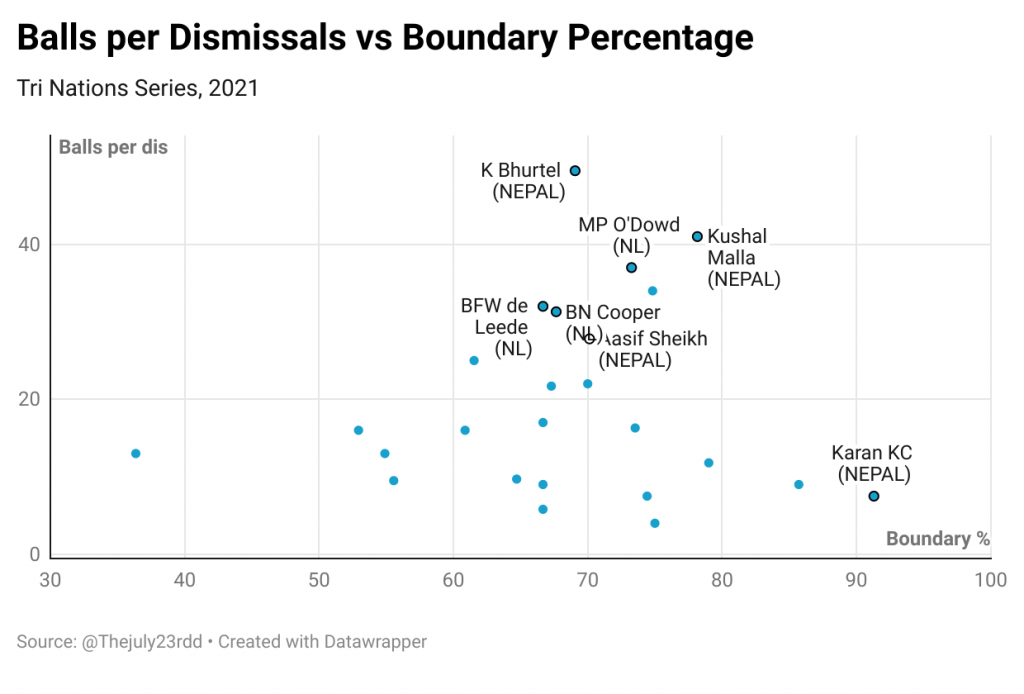Nepal’s batting is barely taken into consideration for the success it has achieved over the years. Thanks to their world-class spinners in the past and their greatest match-winner, Paras Khadka.
But this time in the Tri-Nations Series, things seemed poles apart. One of the major highlights in the tournament was the hosts’ batting extravaganza in the absence of Paras, not to mention an average performance of the spinners and the rise in the morale of the seamers.
The news about his shoulder injury, just a day before the commencement of the series gave the Rhinos an early blow. But the absence of their main batsman in the much-awaited T20I series somehow turned out to be a blessing in disguise for their opening batting. Young middle-order batsman Sandeep Jora replaced Paras in the squad.
Along with his berth, the batting positions at the top had to be adjusted. Head Coach Dav Whatmore gave a chance to the two young debutants, Kushal Bhurtel and Aasif Sheikh to open, and skipper Malla welcomed the coach’s call, batting a step down, at number three. Nepal’s complication with the opening spot had always been an Achilles heel, but this time, it seemed cured, with Whatmore in charge.
Past opening combinations in T20Is
Nepal has been trying and testing its openers for several years. From Subash Khakurel and Sagar Pun in 2014 to Kushal Bhurtel and Aasif Sheikh in 2021, several experiments have been done. The opening duos to recall before the Tri-Nations Series: Subash Khakurel and Sagar Pun, Paras Khadka and Pawan Sarraf, Paras Khadka, Gyanendra Malla, Pradeep Airee and Gyanendra Malla, Ishan Pandey and Paras Khadka, Kushal Malla and Gyanendra Malla. Despite all these experiments, Nepal had not seen desired results in maximizing the capitalization in the powerplay.
On average, Nepal’s batting figures in the powerplay were 40/2, before the start of the Tri-Nations Series. The highest opening partnership was shared between Paras Khadka and Gyanendra Malla (108 runs) while there had only been two instances that the openers shared fifty run-plus partnerships. Pradeep Airee and Gyanendra Malla’s 66-run stand for the first wicket against Malaysia in the ICC T20 World Cup Qualifier 2019 and the next being Paras and Gyanendra’s 108 against Bhutan in SAG Games.
Nepal had scored 50 or more runs in Powerplays once against UAE, Kuwait, Malaysia, Singapore, Bhutan, and Thailand. The highest runs scored in Powerplay was 81 against Bhutan with the lowest being just 17 runs, twice against Hong Kong. This time in the tri-nations series, things seemed to have changed significantly, under World Cup-winning coach Dav Whatmore. From the approach of the play to the batting intent, the young debutants Kushal Bhurtel and Aasif Sheikh partnered with 116 in the series opener against the Netherlands, with both them scoring half-centuries on their debut.
Kushal Bhurtel and Aasif Sheikh
Kushal Bhurtel, the 24-year-old, scored four half-centuries out of five innings he played in the series. With these, he also became the first batter in the world to score three consecutive half-centuries since his/her debut in T20Is. His scores of 62, 61*, 62, 16 and 77 bagged 278 runs in 5 innings, averaging 69.50, with a strike rate of 140.40. He scored the most boundaries in the tournament with 24 fours and 16 sixes.

Bhurtel has scored 400 runs in 38 innings in the Nepalese T20 domestic franchise leagues (EPL, DPL, PPL). He opened for the Pokhara Rhinos from 2018, though had to wait until 2019’s Pokhara Premier League edition to find his only half-century (65*) against the Kathmandu Goldens, guiding his Rhinos to a 9-wicket win. He averaged just 12.12 overall in the domestic T20s with an SR of 109.89 before Covid. Post-Covid, he played only one tournament, the Gautam Buddha Cup, where he scored 110 runs in 3 matches (65, 3, 42). His boundary-hitting ability was a major strength.

Bhurtel scored 66.5% of his total runs (400) from his boundaries in the domestic franchise leagues, the highest percentage among all the Nepalese batsmen in the circuit and has a non-boundary strike rate of 43.37%.
In the Tri-Nations Series, 69.09% of his total runs (278) were contributed from his boundaries while his NB SR has increased to 54.43%. Naturally, Kushal Bhurtel is an aggressive batsman, with Whatmore giving him more confidence to play his natural game. His balls per dismissals increased from 11.03 in domestics to 45.9 in the Tri-Nations series, a mind-blowing change. He has given stability in the opening slot along his boundary hitting capitalizing the most in the Powerplay.
Aasif Sheikh, the 20-year-old, always looked like a wonderkid since he hit a majestic century in the final of the inaugural edition of the Everest Premier League. Guiding his team Panchakanya Tej in their maiden title triumph, Aasif set himself as one to look after in years to come. But apart from these innings, he was yet to really live up to the expectations. In overall domestic T20 franchise leagues, Aasif scored a total of 716 runs with 56.78% of his total runs being contributed by his boundaries. He averages 17.05 in domestic T20s while having a strike rate of just 92.17.

This time in the Tri-Nations series, Aasif on his T20I debut scored 154 runs in 5 innings averaging 38.50, with a strike rate of 138.73. He was the third-highest run-scorer in the Tri-Nations Series. Aasif had a non-boundary strike rate of 51.69 in the series. Seemingly rotating the strike and punishing the bowlers on their loose balls, as soon as Bhurtel converted his innings, Aasif increased his scoring rate, racing for his team.
Both of the batsmen seemed fearless and played exquisite shots, with square cuts and back-foot punches of class. The series also saw some unorthodox shots, the batsmen played some delightful scoops to make the most out of it. Aasif and Bhurtel both had a great debut together scoring a total of 432 runs, nearly more than 50% of the team’s runs. Head Coach Whatmore’s decision to fit in two young debutants as openers in the series was one of the best decisions possible in the absence of Paras Khadka.
Until now, yes they are the best finds in the opening spots, but let’s not forget, these results were in home conditions. They knew well how the pitch would behave especially after playing domestic tournaments like the Prime Minister’s Cup and Mayor’s Cup after the lockdown, and the opposing bowlers bowled below par in the series. The big question would be, can they play similar innings in foreign conditions as well? As Nepal marches forward to the ICC T20 World Cup qualifiers next year, Nepal needs this momentum to get going with Kushal Bhurtel and Aasif Sheikh taking the charge as the openers.
You’re reading Emerging Cricket — brought to you by a passionate group of volunteers with a vision for cricket to be a truly global sport, and a mission to inspire passion to grow the game.
Be sure to check out our homepage for all the latest news, please subscribe for regular updates, and follow EC on Twitter, Facebook, LinkedIn and YouTube.
Don’t know where to start? Check out our features list, country profiles, and subscribe to our podcast.
Support us from US$2 a month — and get exclusive benefits, by becoming an EC Patron.







